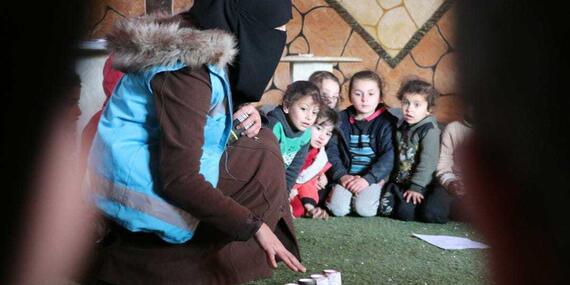Syria: The hidden scars of the earthquakes

by Shirin Yaseen
Thirty hours after her home collapsed in the February earthquake in Kahramanmaraş, Türkiye, rescue teams found Lamees* alive under the rubble. The Syrian mother of two was rushed to the hospital with a broken shoulder, which will take some time to heal.
But the disaster also left Lamees with a wound that she must live with for the rest of her life: She lost her husband, her four-year-old son and her two-year-old daughter in the earthquake.
While Lamees was still in a hospital in Türkiye, their bodies were taken to their family members in Syria, where they were buried. But now, more than a month after the earthquake, Lamees is convinced they are still alive.
Haifaa Al-Masri, a Psychological Counsellor at the Mental and Psychiatric Unit in Sarmada, in Syria’s Idleb Governorate, provides people like Lamees with the support they need. She says time will heal Lamees’ wounds, providing she gets the support she needs.
Al-Masri’s unit has provided many people with psychological support for years, because of the war and the resulting displacement. “And now it is happening again,” she says. “This disaster is different; we don’t usually see earthquakes, but the psychological scars are back. We have made so much progress in the past years and now we are witnessing a setback.”
Counsellors helping counsellors
At least 50,000 people were killed in the earthquakes that struck Türkiye and Syria, including about 6,000 people in Syria, mostly in the north-west. Tens of thousands of people are still missing and hundreds of thousands are homeless. The earthquakes destroyed entire neighbourhoods, rendering them uninhabitable.
Counsellors are vital in north-west Syria, where psychological support is considered taboo. Forty per cent of the women who seek help do so only after years of suffering, explains Al-Masri. But the counsellors try to reach as many people as possible through mobile clinics and a helpline. The counsellors mostly deal with cases of people suffering mild to moderate levels of depression, fear and anxiety. Extreme cases are referred to a specialist.
Alaa Al-Ali is the Technical Supervisor of the mental health and psychosocial support programme in Idleb, which is part of the Union of Medical Care and Relief Organizations — a humanitarian non-governmental organization that provides health care in north-west Syria. He underscores that counsellors’ workload has increased because of the earthquakes’ devastating effects on such a large number of people.
He trains those who provide mental health support to the communities, and his advice to them is: “Before you start, start with yourself. Self-care is very important. If you were not ready psychologically and physically then don’t continue, so that you don’t harm others.”
He also provides health-care providers with guidelines on how to treat people, and he encourages them to be understanding and compassionate.
Supporting the children
According to UNICEF, 2.5 million children are affected by the ongoing conflict in Syria. Every child under age 12 has known nothing but conflict, violence or displacement, and some children have been displaced six or seven times. More than 1.7 million registered refugees from Syria live in Türkiye’s 10 affected provinces — an estimated 811,000 of those people are children.
Walaa’ Al-Zaitoon works with the mental health unit in the Hurras Al-Tofoula (Guardians of Childhood) Network. She helps children to overcome their fears and anxieties, especially after the tremors.
She explains: “We provide mental health assistance to children through various programmes, including the psychodrama programme, which relies on treating cases with arts. We are not treating patients, but we provide mental support through the theatre.”
Through the programme, children can perform plays and dance with each other or with their mothers, and they can tell stories. Al-Zaitoon also helps parents with individual or group sessions.
The most important part of their work is raising awareness among the communities to encourage them to come and talk about these problems.
“Failing to deal with these issues will have an impact on the future of the child,” says Al-Zaitoon. “He or she will grow up with emotional instability, and these symptoms can evolve into mental disorders.”
Low resources, increasing needs
Mental health-care providers face many challenges, including a shortage of financial and human resources. According to Al-Ali, the projects’ continuity depends on the various grants; if the grants stop, the projects stop.
For example, the Sarmada unit was closed for seven months last year, and its patients were asked to leave. In addition, there are only a few specialists in the unit, but the needs are now enormous.
*Name changed
